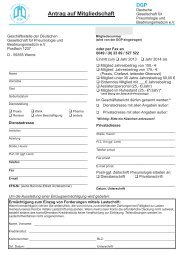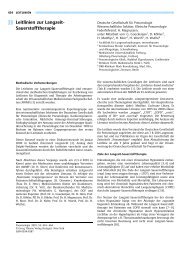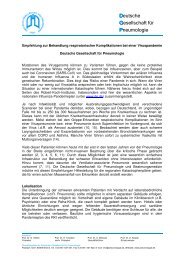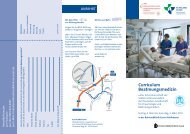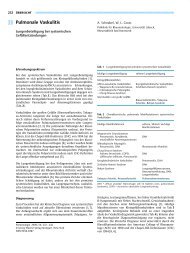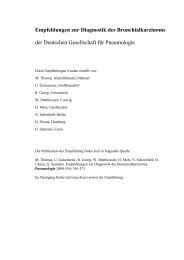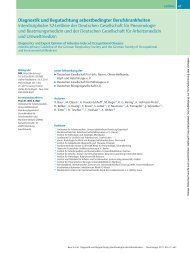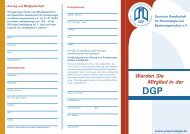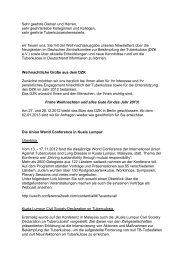Herbsttagung Programm & Abstracts - Deutsche Gesellschaft für ...
Herbsttagung Programm & Abstracts - Deutsche Gesellschaft für ...
Herbsttagung Programm & Abstracts - Deutsche Gesellschaft für ...
Sie wollen auch ein ePaper? Erhöhen Sie die Reichweite Ihrer Titel.
YUMPU macht aus Druck-PDFs automatisch weboptimierte ePaper, die Google liebt.
TLR-3 triggered aggravation of experimental asthma depends on IL-17<br />
Lunding L 1 , Webering S 1 , Vock C 1 , Hölscher C 2 , Fehrenbach H 1 , Wegmann M 1<br />
1<br />
Division of Experimental Pneumology, Research Center Borstel, Airway Research Center North,<br />
Member of the German Center for Lung Research<br />
2<br />
Division of Infection Immunology, Research Center Borstel<br />
Exacerbations represent a distinct characteristic of asthma that imposes considerable morbidity on<br />
patients. Studies that aimed at characterizing the inflammatory pattern of acute asthma exacerbations<br />
displayed a heterogeneous inflammatory infiltrate with eosinophils as well as large numbers of<br />
neutrophils in sputum and broncho-alveolar lavage (BAL), which is different from chronic disease.<br />
Epidemiological surveys suggested viral infections of the respiratory tract as the main trigger.<br />
Respiratory viruses produce double stranded RNA as an intermediate during replication. This can be<br />
sensed by the immune system via toll-like receptor 3 (TLR-3), which could therefore play a critical role<br />
in the pathogenesis of acute asthma exacerbation. Thus, it was the aim to establish a new<br />
exacerbation model of acute asthma and to elucidate the mechanisms underlying TLR-3 triggered<br />
asthma exacerbation. We hypothesized that an exacerbation of the asthmatic phenotype can be<br />
evoked in a mouse model of acute, allergic asthma by intra-nasal application of the synthetic TLR3<br />
ligand poly(I:C).<br />
Mice treated with poly(I:C) showed increased airway hyperresponsivness (AHR) and infiltration of<br />
neutrophils into the lung, i.e. in bronchoalveolar lavage (BAL). The number of eosinophils in BAL as<br />
well as neutrophils was significantly higher in poly(I:C) treated mice compared to asthma control mice.<br />
Increased infiltration of lung tissue with inflammatory cells and increased mucus production was<br />
observed in HE and PAS stained sections. On the mRNA level the expression of pro-inflammatory<br />
cytokines such as IL-5, IL-6, and TNFα and chemokines such as KC, IP-10, and Rantes was<br />
significantly increased. These data were confirmed by increased cytokine levels in the BAL measured<br />
via Cytometric Bead Array (CBA). Although the cytokine IL-17A was not directly measurable in the<br />
BAL, the number of TH17 cells in the lungs were increased in poly(I:C) treated mice. The exacerbation<br />
of experimental asthma induced by poly(I:C) was completely absent in IL-17A deficient mice. In<br />
contrast, deficiency for IL-23, which is essential for the differentiation of TH17 cells, failed to prevent<br />
the asthmatic exacerbation after local application of poly(I:C). These data indicate that IL-17 but not<br />
inevitably TH17 cells contribute to TLR-3 triggered asthma exacerbation in mice.<br />
30




